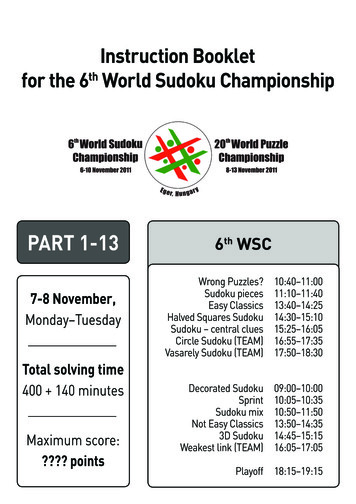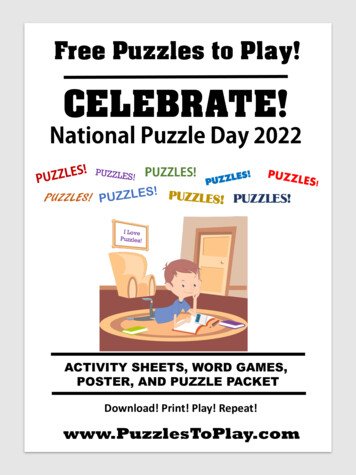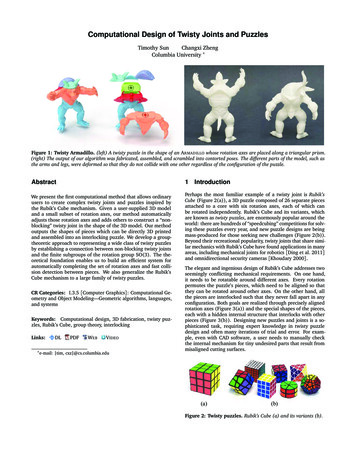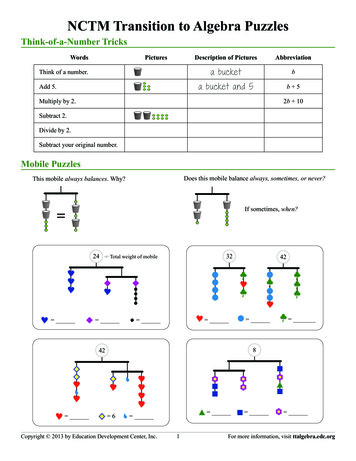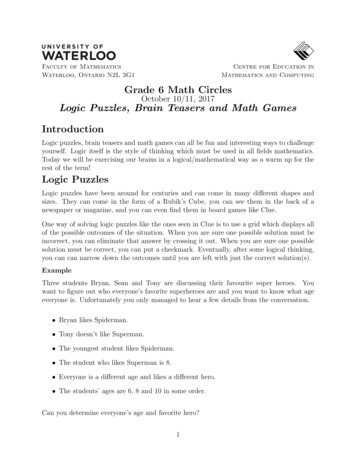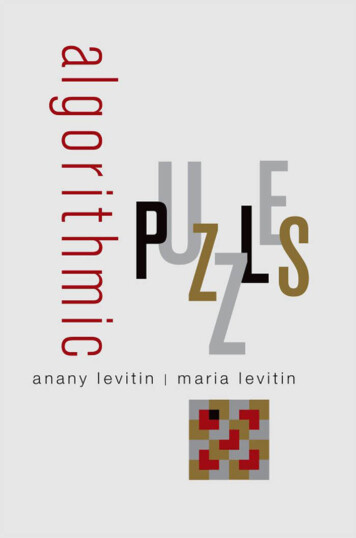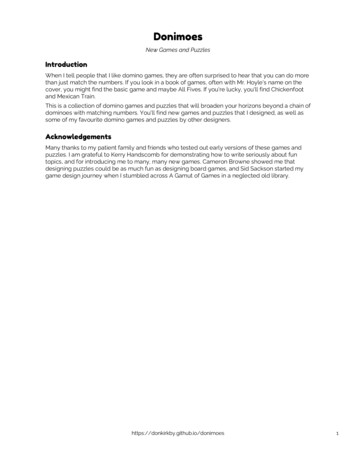
Transcription
DonimoesNew Games and PuzzlesIntroductionWhen I tell people that I like domino games, they are often surprised to hear that you can do morethan just match the numbers. If you look in a book of games, often with Mr. Hoyle's name on thecover, you might find the basic game and maybe All Fives. If you're lucky, you'll find Chickenfootand Mexican Train.This is a collection of domino games and puzzles that will broaden your horizons beyond a chain ofdominoes with matching numbers. You'll find new games and puzzles that I designed, as well assome of my favourite domino games and puzzles by other designers.AcknowledgementsMany thanks to my patient family and friends who tested out early versions of these games andpuzzles. I am grateful to Kerry Handscomb for demonstrating how to write seriously about funtopics, and for introducing me to many, many new games. Cameron Browne showed me thatdesigning puzzles could be as much fun as designing board games, and Sid Sackson started mygame design journey when I stumbled across A Gamut of Games in a neglected old library.https://donkirkby.github.io/donimoes1
Table of ContentsPuzzles . . . . . . . . . . . . . . . . . . . . . . . . . . . . . . . . . . . . . . . . . . . . . . . . . . . . . . . . . . . 3Unmatched Donimoes is a puzzle I designed where you have to slide all the dominoes into arectangular shape, without sliding any matching numbers next to each other. (1 player,double-six dominoes) . . . . . . . . . . . . . . . . . . . . . . . . . . . . . . . . . . . . . . . . . . . . . . . 3Capturing Donimoes is a puzzle I designed where you have to collect all the dominoes by slidingmatching numbers next to each other. (1 player, double-six dominoes) . . . . . . . . . . . . . . 12Mirror Donimoes is a puzzle I designed where pawns walk around on top of the dominoes. (1player, double-six dominoes, 4 pawns) . . . . . . . . . . . . . . . . . . . . . . . . . . . . . . . . . . . 20Games . . . . . . . . . . . . . . . . . . . . . . . . . . . . . . . . . . . . . . . . . . . . . . . . . . . . . . . . . . 28Tetradominoes is a game I designed where you play matching dominoes in a grid, then try toplay the tetromino shapes on top. (1-4 players, double-six dominoes, 7 cardboard tetrominoes,and some beads, buttons, or coins) . . . . . . . . . . . . . . . . . . . . . . . . . . . . . . . . . . . . . 28Bee Donimoes is a puzzle race game I designed where a swarm of dice bring nectar back to thehive. (1-6 players, double-six dominoes, 3-6 dice, and a timer) . . . . . . . . . . . . . . . . . . . . 31Domino Finder is a memory game I designed where you have to find the treasure dominowithout falling in a trap. (2-4 players, double-six dominoes, pawns, and two dice) . . . . . . . . 42By Other Designers . . . . . . . . . . . . . . . . . . . . . . . . . . . . . . . . . . . . . . . . . . . . . . . . . . 43Mountains and Valleys is a solitaire game by Sid Sackson where you have to lay out a map thatyou can hike on. I added a cooperative version, and adapted it from paper, pencil, and dice touse dominoes. (1-4 players, double-six dominoes) . . . . . . . . . . . . . . . . . . . . . . . . . . . . 43Domino Runners is based on board games by Roland Siegers, where your runners run across agrid of dominoes, dropping checkers and trying to capture your opponent's checkers. (2players, double-six dominoes, and checkers) . . . . . . . . . . . . . . . . . . . . . . . . . . . . . . . 45Fujisan is a solitaire game by James Droscha where you help four Shinto priests climb to thepeak of Mount Fuji. I found 20 layouts that are much more challenging than usual. (1 player,double-six dominoes, and four pawns) . . . . . . . . . . . . . . . . . . . . . . . . . . . . . . . . . . . 48Cobra Paw is a quick-reaction game by Derek Weston. (2-4 players, double-six dominoes, andtwo dice) . . . . . . . . . . . . . . . . . . . . . . . . . . . . . . . . . . . . . . . . . . . . . . . . . . . . . . 54All Fives is a traditional dominoes game, where you score points by making the ends add up to amultiple of five. (2-4 players, double-six dominoes) . . . . . . . . . . . . . . . . . . . . . . . . . . . 55Classic Puzzles where you have to lay out dominoes in a given pattern to meet some goal,popularized by Henry Ernest Dudeney. Also includes Dominosa by O.S. Adler. (1 player,double-six dominoes, paper and pencil) . . . . . . . . . . . . . . . . . . . . . . . . . . . . . . . . . . 58Solutions . . . . . . . . . . . . . . . . . . . . . . . . . . . . . . . . . . . . . . . . . . . . . . . . . . . . . . . . . 712
PuzzlesUnmatched DonimoesA puzzle I designed that's the opposite of traditional dominoes: matches are forbidden.GoalThe goal is to slide all the dominoes into a rectangle, without sliding any matching numbers next toeach other.MovesMove a domino one space along its long axis so that none of its numbers match an adjacentnumber on a neighbouring domino. In this example, the lower domino can move to the right,because the three doesn't match the two, and the four doesn't match the 3. You couldn't move itanother space to the right, because then the threes would be right next to each other.Stay ConnectedAll the dominoes in the puzzle have to be connected in one solid group, diagonal connectionsdon't count. When you move a domino, it can be disconnected during the move, as long as it isconnected at the start and the end of the move. Remember that it can only move one space at atime, though.ProblemsHere are the starting positions for several Unmatched Donimoes problems. The solutions are listedat the end.Problem 1Problem 23
Problem 3Problem 4Problem 54
Problem 6Problem 7Problem 85
Problem 9Problem 10Problem 116
Problem 12Problem 137
Problem 14Problem 158
Problem 16Problem 179
Problem 18Problem 1910
Problem 2011
Capturing DonimoesA puzzle I designed to feel like a safari in heavy traffic.GoalThe goal is to collect all the dominoes by sliding matching numbers next to each other.MovesThere are only two ways a domino can move: matching and adding.MatchingMove a domino one space along its long axis so that it ends up with at least one of its numbersmatching an adjacent number on a neighbouring domino. Then collect the domino you moved andany dominoes that match it, by removing them from the pattern. In this example, the threes match,so you collect both dominoes: solution found!AddingMove a domino one space along its long axis so that it ends up with at least one of its numbersnext to an adjacent number that adds up to six. With an adding move, no dominoes are removed. Inthis example, the two adds up with the four above it to make six.Sometimes, you can collect more than two dominoes at once. In the first example, the twomatches twos on both of the other dominoes, and you collect all three dominoes. In the secondexample, the two matches the two to the left, and the four matches the four above it. You collectall three dominoes.12
Stay ConnectedAll the dominoes must stay in one connected group, you can't split the group after moving or afterremoving the matching dominoes.ProblemsHere are the starting positions for several Capturing Donimoes problems. The solutions are listed atthe end.Problem 1Problem 2Problem 3Problem 413
Problem 5Problem 6Problem 7Problem 814
Problem 9Problem 10Problem 1115
Problem 12Problem 13Problem 1416
Problem 15Problem 16Problem 1717
Problem 18Problem 1918
Problem 2019
Mirror DonimoesHelp four ghosts find each other in a haunted house. Each domino is a room in the house, and theghosts can't go through the closed doors. They can go through the mirrors, though. Spooky!GoalMove all the pawns into one connected group. Diagonal connections don't count.StartPlace the dominoes in the starting position shown in the problem, then put a pawn on top of eachcorner space.MovesEach turn, you can make a domino move or a pawn move.Domino MovesThe house is so spooky, the rooms can move. If a domino has one or two pawns on it, you can slidethe domino one space along its long axis. The pawns go along for the ride. You can only move onedomino at a time, and all the dominoes must stay connected in one group before and after themove. Diagonal connections don't count.Remember, a domino with no pawns on it cannot move.Pawn MovesThe ghosts can always move around the room, and they can move through mirrors to the roomnext door. You can move a pawn one space up, down, or sideways, with a few restrictions. Two pawns can't be on the same space, but you can have a pawn at each end of a domino.Moving to a neighbouring domino is only allowed if the number you move to matches thenumber you were on. (There's a mirror for the ghost to go through.)Pawns have to stay on top of the dominoes - no leaving the house.Diagonal moves are not allowed.ExampleHere's a small problem to start with. First, set up the dominoes as shown in the starting position.Then put a pawn on each corner. You can use four identical pawns, but for this example and thesolutions at the end, we use a regular (P)awn, a (B)ishop, a k(N)ight, and a (R)ook as four differenttypes of pawn, so you can keep track of which is which. The small white dots show you the numberunder each pawn.PBNRIn this position, none of the numbers match their neighbours, so there are no mirrors for the pawnsto move between dominoes. However, the 2 under the bishop could match the 2 in the middle, so20
the first move is to slide the bishop's domino down.PNBRNow that there's a mirror to move through, the bishop can move to the left.PNBRThe last move is to join the ghosts into a single, connected group, and there are two choices. Wecan just move the rook to the other end of its domino, or we can slide the rook's domino back up,and the rook comes along for the ride.PNBRProblemsHere are the starting positions for several Mirror Donimoes problems. The solutions are listed at theend.Problem 1Problem 221
Problem 3Problem 4Problem 5Problem 622
Problem 7Problem 8Problem 9Problem 1023
Problem 11Problem 12Problem 1324
Problem 14Problem 15Problem 1625
Problem 17Problem 1826
Problem 19Problem 20You'll need patience for this one. Did I go too far?27
GamesTetradominoesI enjoy classic domino games like All Fives, and I've played recent inventions like Chickenfoot andMexican Train. However, I thought I might be able to design a domino game that felt more like agrid than a chain. Tetradominoes is my attempt to do that.Play matching dominoes in a grid, then try to play the tetromino shapes on top.Players1 to 4 (See the solitaire rules at the end.)Equipment a set of dominoes from double blank to double sixa set of tokens (small chips or cubes that are small enough to fit on top of a domino) - 2 playersneed 1 light token and 1 dark token, 3 players need 3 tokens in each of 3 colours (9 in total), and4 players need 2 light tokens and 2 dark tokensseven cardboard tetrominoes (white on one side, black on the other)To make your own set of tetrominoes, draw these seven shapes on a piece of plain cardboard, andcut them out. Use a marker to colour one side of each shape. Each shape should be big enough fiton top of four domino numbers, with a small gap around the outside.ObjectPlay the most tetrominoes.SetupChoose a player to go first through any convenient method. In a 2-player game, the first playertakes the light token. The other player takes the dark token. In a 3-player game, each player takesall the tokens of one colour. In a 4-player game, the first player and the player opposite each take alight token and the other players take a dark token. Players with the same colour tokens will play aspartners. Shuffle the dominoes face down, and draw four for each player, keeping them hiddenfrom the other players. Put the remaining dominoes and the tetrominoes within reach.28
Playing DominoesOn the first turn, play any domino you like. On each turn after that, you must play a domino so thatat least one of its numbers is adjacent to a matching number on a domino that was already played,and isn't covered. For example, the 36 domino can be added as shown, because the 3 matches itsneighbour.In this example, the 46 cannot be added in this position, but it could be flipped to make the 4 matchits neighbour.You don't have to match along the long side, you could also play it like this.If there are no numbers uncovered at the start of your turn, play a domino so that at least one of itsnumbers is adjacent to a covered number (they don't have to match). If none of your dominoesmatch the available numbers, reveal two of your hidden dominoes, and draw one more, keeping ithidden from the other players. If you still can't play, repeat until you can. If you still can't play whenthere are no more dominoes to draw or when you don't have two hidden dominoes, reveal all ofyour hidden dominoes, and pass your turn. Leave any revealed dominoes face up until you playthem.If you have fewer than four dominoes, draw a domino and keep it hidden from the other players.Playing TetrominoesAfter playing a domino, see if you can play a tetromino. It must cover one or both numbers on thedomino you just played, it can't hang off the edge of the dominoes, and it can't cover any numbersdifferent from the ones on the domino you just played. Also, two tetrominoes of the same colourcan't be right next to each other. (Diagonal is allowed.)For example, if you just played the 46 domino, you could play an L-shaped tetromino on the 4, 4, 4,and 6 numbers.29
With 2 or 4 players, if you have a light token, you must play tetrominoes with the light side up. If youhave a dark token, you must play with the dark side up. With three players, all players playtetrominoes with the light side up, and then place one of their tokens on the tetromino.With 4 players, after a tetromino is played, the two opposing players may each take a domino fromtheir hand, and trade with their partner. This is useful if your partner is about to play and you have adomino that matches something on the board. It can also be useful when you have two dominoesthat will work well together. However, you can't tell your partner how to play what you give them.Game EndWith 2 or 4 players, the game ends when one player or team plays four tetrominoes and wins. With3 players, the game ends when one player plays three tetrominoes and wins.SolitaireAll the rules about playing dominoes and tetrominoes stay the same, but you're trying to fit all ofthe tetrominoes into a small space. You can play the tetrominoes either side up, but you get morepoints if they are mostly the same colour. If you play a domino that can have a tetromino played onit, you must play that tetromino. If you can't play any dominoes, discard one tetromino to count asunplayed, and draw up to four dominoes. Then put the same number of dominoes back in the pile,and shuffle the pile face down.Level 1 - At the end of the game, count the number of black tetrominoes B, the number of whitetetrominoes W, and the number of unplayed tetrominoes X. Calculate your score as BxW 7xX.You win if your score is less than 10.Level 2 - At the end of the game, imagine a rectangle surrounding the dominoes you played.Count the numbers along the longest side, and add that to the level 1 score. You win if your totalscore is less than 15. Good luck!TournamentTournament play is a series of games until one player or team wins seven points. Each game endswhen a player or team plays their fourth tetromino, and then everyone gets one point for eachtetromino they played. The tournament ends immediately when someone scores seven points, noneed to finish the last game.30
Bee DonimoesA puzzle race game where a swarm of dice bring nectar back to the hive.Players1-6Equipment a set of dominoes from double blank to double six3 to 6 six-sided dicea one-minute timerObjectBring the nectar back to the hive in as few moves as possible, faster than the other players. Thebiggest die is the queen bee and doesn't move, the others have to form a connected group aroundher.SetupDecide how many dice you want to use: 3 or 4 are good for learning the game, and 5 or 6 makemore challenging puzzles. Put aside all the dominoes with numbers higher than the number ofdice, and shuffle the rest. Then place the shuffled dominoes face up to form a rectangle ofnumbers.Look for the dominoes with a number at one end and a blank at the other. The number on each ofthose dominoes is the starting space for the die with the matching number. Take 3 dice, turn themso the numbers 1, 2, and 3 are on top, then place them on their starting spaces.For example, here's one possible setup for four dice:PlayThe die with the largest number is the queen bee, which never moves during the round. All thesmaller bees have to bring their nectar back to her in one connected group. (Diagonal connectionsdon't count.)The dice can only land on their own numbers or on unoccupied blanks. They can move in twoways: 1. In a straight line along a row or a column. They can pass over other numbers, squares withtheir own number, or other dice. This counts as one move. 2. Changing direction over other dice. Inthe middle of a regular move, a die may make a 90 turn directly above another die. Later in thesame move, it may make more turns directly above other dice. No matter how many turns itmakes, this still counts as one move.31
See the example solution after the rules.SolveAs soon as the queen bee is placed, all players try to solve the puzzle at the same time. Do nottouch the dominoes or dice while you are trying to solve the puzzle! Once a player has found asolution, they say the number of moves they need, and start the timer. The other players have untilthe timer ends to find a better solution.A solution with fewer moves is always better. If two players find solutions with the same number ofmoves, then the player with fewer points wins the tie. If they have the same points, then the playerwho said it first wins the tie.If there is no solution, then the first player to say it's impossible starts the timer. They win the roundif no other player can find a solution before the timer ends.DemonstrateWhichever player has claimed the best solution when the timer ends has to demonstrate thatsolution, counting the moves out loud. Players should demonstrate with no more than a fewseconds of hesitation. If they made a mistake or can't remember the solution, let the player whoclaimed the next best solution demonstrate it.The player who successfully demonstrates a solution scores one point.Next RoundPut the dice back on their starting spaces. If there are any empty starting spaces, start the nextround by adding the next bigger die on its starting space. Otherwise, shuffle all the dominoes andset up again.Example SolutionLet's solve the set up above, where the 3 die is the queen bee. The first thing to do is checkwhether there are enough places for the bees to land around the queen bee. The queen issurrounded on three sides by 3s and 4s, so something has to land on the wild space. Next to that isa 4 and a 2, so you know that the 1 has to end up on the wild space with the 2 next to it.Now that we know where we're going, it seems best to start by moving the 2 where it can guidethe 1 onto the wild spot:With the 2 in place, the 1 can get to its target.32
Finally, the 2 can get to its target with the help of the 1, in a nice leapfrog pattern.End GamePlay for an agreed number of rounds, the player with the most points wins. In case of a tie, play anextra round.To play a series of games, start with 3 dice and play 1 round. Add in another die and all thedominoes with numbers up to 4, then play 2 rounds. Continue with 5 and 6 dice for a total of 10rounds.For experienced players, play 3 cycles with 6 dice for a total of 12 rounds.Advanced VersionLetting the dice land on the blanks makes the game easier to solve. For more challenging puzzles,only let the dice land on one blank: the blank on the queen bee's domino.If you find the race too stressful, play cooperatively or as a solitaire.ProblemsWhen you randomly lay out the dominoes, most solutions will take between 3 and 6 moves. Hereare some carefully chosen layouts that range from easy to very challenging. Record how manymoves you used for each queen bee, and then compare to the solutions at the end. Theseproblems all use the advanced version of the rules, so the only blank you can land on is the one onthe queen bee's domino.33
Problem 1Problem 2Problem 3Problem 434
Problem 5Problem 6Problem 735
Problem 8Problem 9Problem 1036
Problem 11Problem 1237
Problem 13Problem 1438
Problem 15Problem 1639
Problem 17Problem 1840
Problem 19Problem 2041
Domino FinderA memory game with hidden traps.Players2-4Equipment a set of dominoes from double blank to double sixone pawn for each player, in different colourstwo six-sided diceObjectFor 2 players, find 5 treasure dominoes. 3 players find 4, or 4 players find 3.SetupFind the 7 dominoes that have blanks, gather them into a pile, and shuffle them face down. Shufflethe other 21 dominoes face down in a separate pile. Then, take 1 domino from the blanks pile and 3from the other pile. Shuffle them together so you don't know what numbers they have and youdon't know which has a blank. Lay them out face down in a long thin row. Repeat the process untilyou have 7 rows side by side, but leave gaps between the rows so you can turn them over as youplay. You should end up with a rectangle of 7x8 secret numbers.Each player rolls the two dice, and the highest number plays first. Reroll to break ties. The startingplayer rolls the two dice to choose the treasure domino.PlayOn your first turn, place your pawn next to one of the face-down dominoes along the edge of theboard. Every turn, you flip up one face-down domino, and move your pawn onto it. Your pawnmust be next to the domino you want to flip up, but you may move it over dominoes that arealready face up, before you get to the domino you want to flip up. You may also move it overempty spaces where dominoes have been removed. You may not move it over blanks orface-down dominoes. Once your pawn is next to the face-down domino you want to flip, placeyour pawn next to one end, and then flip the domino around the long axis, so the numbers stay inthe same position. If you flip over a blank square next to your pawn, then you stepped in a trap!Place your pawn on the blank square, and skip your next turn.If you flip over a domino that matches the two dice, you found the treasure! Place the treasuredomino face up in front of you, move your pawn into the empty space, and prepare for the nexttreasure: * Flip every revealed trap so that it is face down, unless there's a pawn on it. * Roll the diceto see what the next treasure is. * If you roll numbers that match a previous treasure domino that'snow in front of a player or if they match a domino that a player's pawn is on, just roll again. * If youroll numbers that match a face-up domino, flip it face down. Roll again.Whether you found the treasure or not, your turn ends after flipping one domino. The turn passesto the player on your right.WinningAs soon as you collect enough treasures, you win the game.42
By Other DesignersMountains and ValleysSid Sackson is one of my favourite game designers. He designed Acquire, Can't Stop, and I'm theBoss, among many, many others. He included Mountains and Valleys in his Beyond Solitaire book,and I adapted it from paper, pencil, and dice to use dominoes.To start, shuffle a set of double-six dominoes face down, then turn 18 of them face up. Theremaining 10 aren't used. Then arrange the dominoes into a 6x6 square of numbers that representsa map of mountains and valleys, where blanks are at sea level, and sixes are the highest peaks. Thegoal is to make a map where you can walk to every square. You can walk from one square to itsneighbour if the two heights are the same or differ by one. (You can't climb cliffs.)For example, this set of 18 dominoes:can be arranged into this solution, where the grey lines show the paths you can walk along:I like this solitaire, because it can almost always be solved, though finding a solution can be verydifficult. There's usually more than one solution. For example, you can flip the 56 domino, above.There is a trivially unsolvable situation whenever one of the numbers from 1 to 5 is completelymissing, but that can be quickly checked, and I haven't found any other unsolvable combinations.43
Cooperative VersionYou can play Mountains and Valleys cooperatively with other players. Shuffle the dominoes facedown, then draw 9, 6, or 5 dominoes each when there are 2, 3, or 4 players, respectively. Keep yourdominoes hidden from the other players.Randomly choose a player to go first. That player chooses one of their dominoes and passes it tothe player on their left. The player receiving the domino plays it on the table, then chooses one oftheir dominoes and passes it to the player on their left. Play continues in the same pattern until a6x6 square is complete. After the first domino, all dominoes must be played so they have at leastone neighbour, and they can't be moved after they are added.When the 6x6 square is complete, see if the whole map is connected as described in the solitairegame. If you need a step of more than one level to get from one section of the map to another, youget a penalty of the number of levels. For example, if a map is completely connected except thatyou need to go from a 3 to a 5, then you would have a 2 point penalty. A perfect game is zero, andanything under 5 is a good game.With four players, the last two players will each have an extra domino left at the end of the game.For a harder solitaire version, draw 18 dominoes, but only turn five of them face up. Each time youplay a domino, turn another one face up, until you've turned up all 18. Then play the last five. Usethe same placement and scoring rules as the cooperative version.44
Domino RunnersRoland Siegers used an unusual mechanic in two board games: Winkeladvokat (1986) and Cabale(1999). Each turn, your runner makes a V-shaped move, and drops a marker at the bend. I've playedmany games of Cabale, which uses a hexagonal grid. When I learned that Winkeladvokat uses thesame mechanic on a square grid, I thought it would adapt well to play on a grid of dominoes.Equipment a set of dominoes from double blank to double sixten checkers for each player, in different colours, that will fit on half a dominoone runner for each player, in colours to match the checkers, they can be pawns or a stack oftwo checkersa neutral runner in a third colour (optional)StartShuffle all the dominoes face down, and then place them in a 7x8 grid of numbers, flipping themface up as you go.Randomly choose colours for the two players. The player with the darker colour starts, placingtheir runner on one end of any domino. The player with the lighter colour then has a choice: eitherplace their runner somewhere else on the dominoes, or swap colours and force the other player toplace the lighter runner. This means that if the first player makes too strong a first move, thesecond player can steal it.Here's an example starting position, where there are several fives and sixes protected by blanks orthe edge of the board. The black player decided to line up with two of the fives, so the white playerwould choose to line up with a six instead of swapping colours. The little white pips show you whatnumber is underneath each runner.BWPlayOn each turn, move your runner in two parts: vertical then horizontal or horizontal then vertical.Each part must move at least one space across the board. Start by replacing your runner with theneutral runner, then move your runner as described. It cannot cross over another runner or anycheckers. After moving the runner, place one of your checkers on the space where the runnerchanged direction. Important: you cannot place a checker on a blank space, so you cannot changedirection on a blank space.45
Here's what the black player might do on the first move of the example game. The neutral runner isoptional, and helps you see where you started your move. The black runner turned at the 5 anddropped a black checker, then moved up to the blank and stopped.BNWAfter placing the checker, you may use it to jump over one of your opponent's checkers, if the twocheckers are right next to each other and there's an empty space on the other side. You may notjump diagonally, and you may not land on a blank space. You may continue jumping anotherchecker after you land, with the same rules.Once you finish, your opponent takes a turn.After a few moves in the example game, the white player has left some checkers unprotected. Youcan see the neutral runner where the black runner started, and the corner where the black playerdropped a checker. Then that checker jumped over the white checker on the four and then overthe white checker on the three. Both the white checkers can now be removed by the black player.NWB46
WinningThe game ends in one of two ways: either both players place all their checkers, or a player can'tmake a legal move. If a player can't make a legal move, they lose. If both players have played alltheir checkers, look under the checkers, and add up all the covered numbers, then add one morepoint for every captured checker. The player with the most points wins.In the example game, the white player has made another mistake, and can't make a legal move.You might think that white could move one to the right and then down the empty column, butremember that you can't drop a checker on a blank. White loses the game, and it doesn't matterhow many points are under the checkers.WB47
FujisanJames Droscha is best known as the designer of the piecepack game system, and he designedFujisan for the piecepack, then ada
Donimoes: New Games and Puzzles When I tell people that I like domino games, they are often surprised to hear that you can do more than just match the numbers. If you look in a book of games, often with Mr. Hoyle's name on the cover, you might find the basic game and maybe All Fives. If

